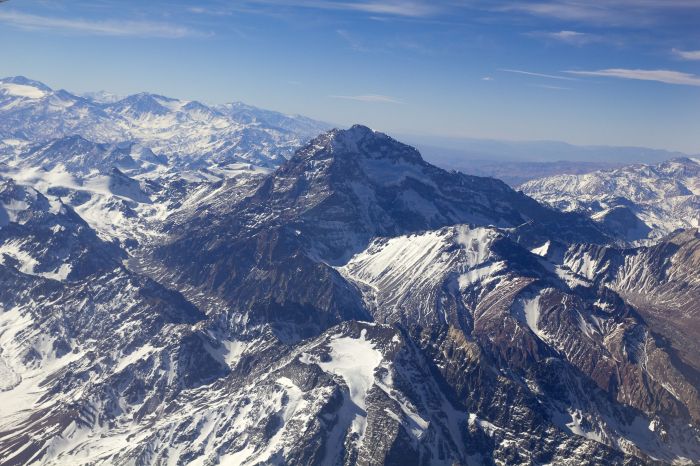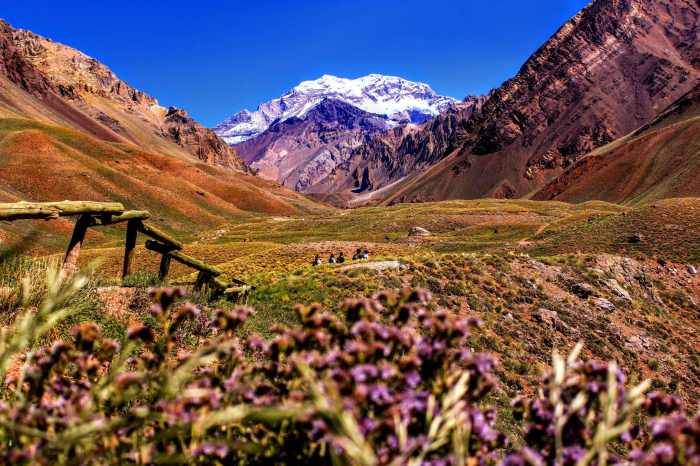Aconcagua, the colossal sentinel of the Andes, stands as the highest peak in the Americas, beckoning adventurers and nature enthusiasts alike to unravel its grandeur and embrace its challenges. This majestic mountain, a testament to the power of nature, invites us on an extraordinary journey to explore its geological wonders, cultural significance, and ecological marvels.
From its towering summit to its rugged slopes, Aconcagua offers a captivating tapestry of landscapes and experiences. Whether you’re an avid climber seeking to conquer its icy heights or a curious traveler eager to immerse yourself in its natural and cultural heritage, Aconcagua promises an unforgettable encounter.
Geographical Overview

Aconcagua, the colossal sentinel of the Andes, stands tall as the highest peak outside of Asia. Its majestic summit pierces the heavens at an awe-inspiring altitude of 6,961 meters (22,838 feet) above sea level, making it the undisputed monarch of the Western Hemisphere.
Aconcagua, the majestic peak in the Andes, stands tall as the highest mountain outside of Asia. Its towering presence invites adventurers from around the globe to embark on challenging treks. However, for those seeking a more leisurely experience, Albert Park in Melbourne offers a picturesque retreat.
Nestled amidst lush greenery and serene lakes, Albert Park provides a tranquil haven just a stone’s throw from the vibrant city center. While Aconcagua beckons with its rugged grandeur, Albert Park offers a peaceful escape where one can rejuvenate amidst nature’s embrace.
The discovery of Aconcagua can be traced back to the intrepid Spanish conquistadors who ventured into the South American wilderness in the 16th century. The first recorded ascent to its summit was achieved in 1897 by the Swiss mountaineer Matthias Zurbriggen, who etched his name into the annals of mountaineering history.
Geological Formation and Composition
Aconcagua’s geological origins are deeply intertwined with the colossal forces that shaped the Andes mountain range. The mountain is primarily composed of igneous and metamorphic rocks, bearing witness to the volcanic eruptions and tectonic upheavals that have sculpted its rugged form over millions of years.
The mighty Aconcagua, the highest peak in the Americas, stands as a testament to the indomitable spirit of adventurers. Those seeking a more accessible adventure can find it at Adventure Island Tampa , a thrilling water park that offers a splash of excitement for all ages.
While the towering Aconcagua may be a distant dream, Adventure Island Tampa provides a refreshing escape for those seeking an adrenaline rush closer to home.
The lower slopes of Aconcagua are adorned with sedimentary rocks, remnants of ancient marine environments that once covered the region. As one ascends the mountain, the landscape transitions to igneous rocks, formed from the cooling of molten magma. The summit, a breathtaking spectacle of snow and ice, is capped by metamorphic rocks, transformed by intense heat and pressure.
Climbing Routes and Challenges
Reaching the summit of Aconcagua presents climbers with a formidable undertaking. The mountain’s towering height and extreme conditions demand meticulous planning and technical proficiency. Several established routes offer access to the peak, each posing unique challenges and rewards.
Normal Route
The Normal Route is the most popular and accessible ascent path, suitable for climbers of varying experience levels. It begins at the Horcones Valley and gradually ascends through the mountain’s lower slopes. The route traverses several glaciers and steep terrain, culminating in the summit ridge. While technically less demanding than other routes, the Normal Route still requires climbers to contend with altitude sickness, unpredictable weather, and physical exhaustion.
Polish Glacier Traverse
For a more challenging experience, climbers can opt for the Polish Glacier Traverse. This route involves crossing the Polish Glacier, known for its treacherous crevasses and icefalls. Climbers must navigate the glacier’s unstable terrain, often using ropes and ice axes for safety. The route offers stunning views of the surrounding peaks and glaciers but demands exceptional technical skills and endurance.
Falso de los Polacos
The Falso de los Polacos route is considered one of the most difficult and dangerous ascents on Aconcagua. It traverses the mountain’s south face, renowned for its steep ice and rock walls. Climbers face extreme exposure, requiring expert mountaineering techniques and a high level of physical fitness. The route is often attempted by experienced climbers seeking a true test of their abilities.
Acclimatization
Prior to attempting any Aconcagua ascent, climbers must undergo a rigorous acclimatization process. This involves gradually ascending and descending the mountain to allow their bodies to adjust to the high altitude. Proper acclimatization reduces the risk of altitude sickness and improves overall performance during the climb. Climbers typically spend several days at base camp and intermediate camps, making acclimatization hikes and monitoring their physical condition.
Flora and Fauna

Aconcagua is a diverse ecosystem, with a wide range of plant and animal species adapted to the harsh conditions of the mountain. The mountain’s unique flora and fauna are influenced by its altitude, climate, and rugged terrain.
At lower elevations, the mountain is home to a variety of vegetation, including shrubs, grasses, and wildflowers. As the altitude increases, the vegetation becomes more sparse, with only a few hardy species able to survive the cold, dry conditions. Near the summit, the only plants that can survive are mosses and lichens.
Aconcagua is also home to a variety of animal species, including guanacos, vicuñas, and condors. These animals have adapted to the mountain’s harsh conditions, and they play an important role in the ecosystem. Guanacos and vicuñas graze on the mountain’s vegetation, while condors scavenge on the remains of dead animals.
Conservation Efforts
Aconcagua is a protected area, and there are a number of conservation efforts in place to protect its biodiversity. These efforts include:
– Regulating the number of climbers on the mountain
– Establishing protected areas for wildlife
– Educating climbers about the importance of protecting the mountain’s environment
These conservation efforts are essential for protecting Aconcagua’s unique flora and fauna. By working together, we can ensure that this beautiful mountain remains a haven for wildlife for generations to come.
Cultural Significance

Aconcagua holds immense cultural and spiritual significance for the local indigenous communities, particularly the Inca and Quechua peoples. To them, the mountain represents a sacred deity and a symbol of power, strength, and endurance.
Traditional Beliefs and Practices, Aconcagua
In Inca mythology, Aconcagua is known as “Apu” or “Lord of the Mountains.” It is believed to be the dwelling place of the Inca god Viracocha, who is said to have created the world and its inhabitants. The Inca revered Aconcagua and offered sacrifices and prayers at its base. They also believed that climbing the mountain was a sacred pilgrimage that would bring good fortune and protection.
The Quechua people, who also inhabit the region, share similar beliefs and practices. They consider Aconcagua to be a protector and provider, and they often pray to the mountain for guidance and assistance. They also hold traditional ceremonies and rituals at the base of the mountain to honor its spiritual significance.
Role in Modern-Day Cultural Expressions
Aconcagua continues to play a vital role in modern-day cultural expressions. It is a popular destination for hikers and climbers from around the world, who are drawn to its beauty, challenge, and spiritual significance. The mountain has also been featured in numerous works of art, literature, and music, including the poem “Aconcagua” by Pablo Neruda.
In addition, Aconcagua has become a symbol of national pride for Argentina and Chile. It is featured on the Argentine 10-peso bill and is often used in marketing and tourism campaigns. The mountain also serves as a reminder of the rich cultural heritage of the region and the importance of preserving its natural beauty.
Tourism and Environmental Impact

The influx of tourists to Aconcagua has undoubtedly left an imprint on its pristine environment. The sheer number of climbers, coupled with the logistical requirements of supporting their expeditions, has led to concerns about the ecological footprint of mountaineering.
In recognition of these concerns, several measures have been implemented to minimize the impact of tourism. Climbers are required to obtain permits and adhere to strict regulations, such as designated camping zones and waste disposal protocols. The use of motorized vehicles is prohibited within the park, and climbers are encouraged to practice “leave no trace” principles.
Mount Aconcagua, the towering peak in the Andes, stands as the highest mountain outside of Asia. Its rugged slopes and unforgiving terrain have captivated mountaineers for centuries. However, even the most experienced climbers must prepare meticulously for the ascent. For a glimpse into the world of performing arts, consider exploring the Apollo Theater , a legendary venue that has hosted countless musical icons.
The theater’s rich history and intimate atmosphere make it a pilgrimage site for music lovers. Yet, just as Aconcagua’s summit beckons mountaineers, the Apollo Theater’s stage continues to inspire and ignite the passions of aspiring artists.
Sustainable Practices
Beyond regulatory measures, sustainable practices have been embraced to preserve the mountain’s natural beauty. These include:
- Waste Management: Climbers are responsible for carrying out all their waste, including human waste, to designated disposal sites.
- Water Conservation: Climbers are encouraged to treat and conserve water, as the mountain’s water sources are limited.
- Trail Maintenance: Trails are regularly maintained to prevent erosion and preserve the delicate alpine ecosystem.
- Education and Awareness: Climbers are educated about the importance of environmental conservation and encouraged to adopt responsible practices.
Conclusive Thoughts
As we bid farewell to Aconcagua, its towering presence lingers in our hearts and minds, a reminder of the indomitable spirit of nature and the boundless possibilities that lie within our reach. Whether you have scaled its heights or simply marveled at its beauty from afar, Aconcagua’s legacy endures, inspiring us to embrace adventure, appreciate the wonders of the natural world, and strive for greatness in all that we do.
Frequently Asked Questions: Aconcagua
How tall is Aconcagua?
Aconcagua stands at an impressive height of 6,961 meters (22,838 feet) above sea level.
What is the best time to climb Aconcagua?
The optimal climbing season for Aconcagua runs from December to February, when weather conditions are generally more favorable.
Is Aconcagua a difficult mountain to climb?
Yes, Aconcagua is considered a challenging climb due to its high altitude, unpredictable weather, and technical sections.
What is the success rate for climbing Aconcagua?
The success rate for reaching the summit of Aconcagua varies depending on factors such as weather conditions and climber experience, but it is typically around 30-40%.